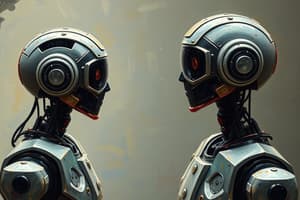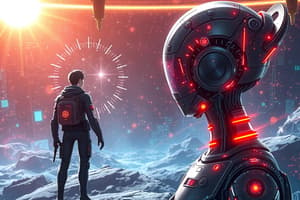Podcast
Questions and Answers
Which of the following best describes an agent in the context of artificial intelligence?
Which of the following best describes an agent in the context of artificial intelligence?
- An entity that interacts with its environment through sensors and effectors. (correct)
- A passive observer that records data from its environment.
- A static component that does not adapt to changes in the environment.
- A system that operates independently of any external input.
A rational agent always makes the correct decision, even with incomplete information.
A rational agent always makes the correct decision, even with incomplete information.
False (B)
What term describes the complete set of inputs an agent receives at a given time?
What term describes the complete set of inputs an agent receives at a given time?
percepts
An operation involving an __________ is called an action.
An operation involving an __________ is called an action.
Match each type of agent with its corresponding description:
Match each type of agent with its corresponding description:
Which of the following is NOT typically considered a factor in rational agent considerations?
Which of the following is NOT typically considered a factor in rational agent considerations?
An omniscient agent always knows the outcome of its actions.
An omniscient agent always knows the outcome of its actions.
What is the term for rationality that takes an agent's limitations into account?
What is the term for rationality that takes an agent's limitations into account?
The acronym __________ is used to describe the attributes of the environment in which an agent exists.
The acronym __________ is used to describe the attributes of the environment in which an agent exists.
What does the 'P' in PEAS stand for when describing an agent?
What does the 'P' in PEAS stand for when describing an agent?
In the PEAS framework, the Environment refers only to the physical surroundings of the agent.
In the PEAS framework, the Environment refers only to the physical surroundings of the agent.
In the context of agents, what are actuators used for?
In the context of agents, what are actuators used for?
__________ provide information about the current state of the environment to an agent.
__________ provide information about the current state of the environment to an agent.
Which of the following is an example of an actuator for an automated taxi driver?
Which of the following is an example of an actuator for an automated taxi driver?
A fully observable environment means that the agent has access to the complete state of the environment at all times.
A fully observable environment means that the agent has access to the complete state of the environment at all times.
What is the difference between 'deterministic' and 'stochastic' environments?
What is the difference between 'deterministic' and 'stochastic' environments?
In an __________ environment, the agent's experience is divided into atomic episodes.
In an __________ environment, the agent's experience is divided into atomic episodes.
Which of the following best describes a 'static' environment?
Which of the following best describes a 'static' environment?
In a discrete environment, there are a limited number of distinct percepts and actions.
In a discrete environment, there are a limited number of distinct percepts and actions.
What is the primary difference between a single-agent and a multi-agent environment?
What is the primary difference between a single-agent and a multi-agent environment?
An environment is considered __________ when the agent knows the 'laws of physics' that govern it.
An environment is considered __________ when the agent knows the 'laws of physics' that govern it.
Which type of agent program keeps track of the world around it?
Which type of agent program keeps track of the world around it?
A simple reflex agent makes decisions based solely on its current percept, without considering past percepts.
A simple reflex agent makes decisions based solely on its current percept, without considering past percepts.
What is the defining trait of a goal-based agent?
What is the defining trait of a goal-based agent?
__________ agents act to maximize their own 'happiness'.
__________ agents act to maximize their own 'happiness'.
Flashcards
What is an Agent?
What is an Agent?
An entity that interacts with its environment, perceiving through sensors and acting through effectors or actuators.
Human Agent Sensors
Human Agent Sensors
Eyes, ears, skin, taste buds etc.
Human Agent Actuators
Human Agent Actuators
Hands, fingers, legs, mouth, etc.
What is a Percept?
What is a Percept?
Signup and view all the flashcards
Agent Action
Agent Action
Signup and view all the flashcards
Agent Function
Agent Function
Signup and view all the flashcards
Agent Program
Agent Program
Signup and view all the flashcards
The Right Thing
The Right Thing
Signup and view all the flashcards
Rational Agent
Rational Agent
Signup and view all the flashcards
Limited rationality
Limited rationality
Signup and view all the flashcards
PEAS
PEAS
Signup and view all the flashcards
Taxi Driver - Performance
Taxi Driver - Performance
Signup and view all the flashcards
Taxi Driver - Environment
Taxi Driver - Environment
Signup and view all the flashcards
Taxi Driver - Actuators
Taxi Driver - Actuators
Signup and view all the flashcards
Taxi Driver - Sensors
Taxi Driver - Sensors
Signup and view all the flashcards
Fully Observable Environment
Fully Observable Environment
Signup and view all the flashcards
Dynamic Environment
Dynamic Environment
Signup and view all the flashcards
Single Agent Environment
Single Agent Environment
Signup and view all the flashcards
Environment & Agent Design
Environment & Agent Design
Signup and view all the flashcards
Model-based agent
Model-based agent
Signup and view all the flashcards
Study Notes
- An agent generally interacts with its environment through sensors for perception and effectors or actuators for actions.
Agent Examples
- Human agents use eyes, ears, skin, and taste buds for sensors, and hands, fingers, legs, and the mouth for actuators, which are powered by muscles.
- Robots use cameras, infrared, and bumpers for sensors, and grippers, wheels, lights, and speakers for actuators, often powered by motors.
- Software agents function as sensors using information provided as input in the form of encoded bit strings or symbols and function as actuators using results to deliver the output.
Agents and Environments
- An agent perceives its environment through sensors and can change it through actuators.
- A complete set of inputs at a given time is called a percept.
- The current percept or a sequence of percepts can influence an agent's actions.
- An operation involving an actuator is called an action, and actions can be grouped into action sequences.
Agents and Their Actions
- A rational agent does "the right thing," which leads to the best outcome.
- An agent function maps percept sequences to actions, described abstractly.
- An agent program is a concrete implementation of the agent, running on a specific agent architecture or platform.
- Problems may arise with AI agents such as, what ‘the right thing’ is and how to measure the best outcome
Performance of Agents
- Performance is measured by the outcome and expenses of the agent.
- Performance criteria should be objective and are task-dependent, time is also important.
Performance Evaluation Examples
- For a vacuum agent, performance can be measured by the number of tiles cleaned.
- The number of tiles cleaned can be determined by the agent's report or validated by an objective authority.
- Performance evaluations often do not consider the expenses of the agent or side effects like energy, noise, loss of useful objects, damaged furniture, or scratched floors.
- A vacuum agent might re-clean clean tiles, cover only part of the room, or drop dirt to have more tiles to clean, which leads to unwanted activities.
Rational Agent
- These selects the action that are expected to maximize its performance based on a performance measure, taking into account percept sequence, background knowledge, and feasible actions.
Rational Agent Considerations
- Considers the performance measure for successful completion of a task, complete perceptual history (percept sequence), background knowledge (especially about the environment, including dimensions, structure, and basic "laws"), and feasible actions, like the capabilities of the agent.
Omniscience
- A rational agent is not omniscient and doesn't know the actual outcome of its actions or certain aspects of its environment.
Limited Rationality
- Takes into account the limitations of the agent, including percept sequence, background knowledge, and feasible actions.
- It deals with the expected outcome of actions.
PEAS Description
- PEAS stands for Performance, Environment, Actuator and Sensors
- PEAS is used to specify the composition of designed AI agents.
PEAS Metrics: Autonomous Taxi Driver
- Performance: A safe, fast, legal, comfortable trip to maximize profits.
- Environment: Roads, other traffic, pedestrians, customers.
- Actuator: Steering wheel, accelerator, brake, signal, horn.
- Sensors: Cameras, sonar, speedometer, GPS, odometer, engine sensors, keyboard.
Environment Types
- Fully Observable vs. Partially Observable: A fully observable environment's sensors give complete access to its state at any point in time, and partially observable is the reverse.
- Deterministic vs. Stochastic: A deterministic environment’s next state is completely determined by the current state and the action executed by the agent, whereas a stochastic environment is the opposite.
- Episodic vs. Sequential: In an episodic environment, the agent's experience is divided into atomic "episodes," where the choice of action depends only on the episode itself; sequential is the opposite.
Enviroment Classifications
- Static vs. Dynamic: A static environment is unchanged while the agent is deliberating; the opposite is dynamic.
- Discrete vs. Continuous: A discrete environment has a limited number of distinct, clearly defined percepts and actions, the opposite is continuous.
- Single Agent vs. Multiagent: A single agent environment has the agent operating by itself, the opposite has multiple agents in the environment.
- Known vs. Unknown: This distinction refers not to the environment itself but to the agent's or designer's state of knowledge about the "laws of physics" of the environment.
Environment Type Examples
- Chess with a Clock: Fully observable, deterministic, not episodic, semi-static, discrete, single agent.
- Chess without a Clock: Fully observable, deterministic, not episodic, static, discrete, single agent.
- Taxi Driving: Not fully observable, not deterministic, not episodic, not static, not discrete, single agent.
- The environment type largely determines the agent design.
- The real world is (of course) partially observable, stochastic, sequential, dynamic, continuous, and multi-agent.
Agent Program Types
- Agent Programs achieve mapping from percepts to actions with different levels of complexity.
- These programs can be:
- Simple reflex agents.
- Model-based agents, which keep track of the world.
- Goal-based agents, which work towards a goal.
- Utility-based agents.
- Learning agents.
Studying That Suits You
Use AI to generate personalized quizzes and flashcards to suit your learning preferences.




